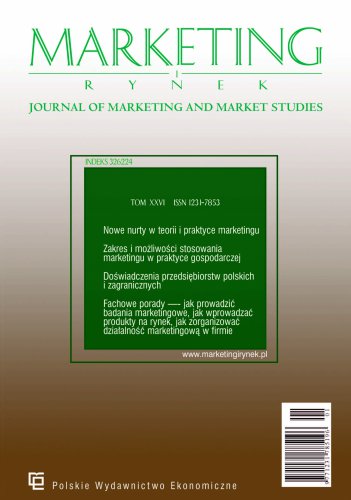Subjective measures in assessing the competitive position of a sports club brand
The purpose of this study is to identify the measures used in assessing the competitive position of an organization's brand and to indicate the factors shaping these measures. In the process of exploring the researched issue, the example of football clubs was used. The study focuses on the group of subjective measures. In the article the authors attempted to systematize knowledge in the area of brand strength resulting from its competitive position and the factors determining this position. The conclusion was supported by the analysis of the literature on the subject of brand creation and management.
References
Aaker, D. A. (1991). Managing brand equity. Capitalizing on the value of a brand name. The Free Press.
Aceves, L., Murillo, D., & Urena, G. (2018). Digital engagement and social identity of sports fans: The case of Premier League teams on Facebook. Revista iberoamericana de psicología del ejercicio y el deporte, 13(1).
Aksoy, R., & Tokmak G. (2016). Factors affecting brand loyalty in football: An application on "The Big Four" foorball clubs in Turkish Super League. International Review of Economics and Management, 4(3).
Anagnostopoulos, Ch., Willem, A., Zeimers, G., & Zintz, T. (2018). Corporate social responsibility (CSR) in football: Exploring modes of CSR implementation. W: Ch. Anagnostopoulos, S. Chadwick, D. Parnell, & P. Widdop (Red.), Routledge Handbook of Football Business and Management. 1st Edition. Routledge.
Bardhi, F., Bengtsson, A., & Venkatraman, M. (2010). How global brands travel with consumers: An examination of the relationship between brand consistency and meaning across national boundaries. International Marketing Review, 27(5).
Biscaia, R., Gordon, B., Nakazawa, M., & Yoshida, M. (2014). Conceptualization and measurement of fan engagement: Empirical evidence from a professional sport context. Journal of Sport Management, 28(4).
Brzeźniak, M. (2017). Budowanie świadomości marki w klubie sportowym. Wydawnictwo Naukowe Katedra.
Chmykhov, A., Naidenova, I., & Parshakov, P. (2016). Does football sponsorship improve company performance? European Sport Management Quarterly, 16(2).
De Chernatony, L. (2003). Marka. Wizja i tworzenie marki. Gdańskie Wydawnictwo Psychologiczne.
Deloitte Football Money League. (2020). https://www2.deloitte.com/uk/en/pages/sports-business-group/articles/deloitte-football-money-league.html
Dziekoński, M., Kozielski, R., & Pogorzelski, J. (2017). Komunikacja marketingowa. W: R. Kozielski (Red.), Wskaźniki marketingowe. Wyd. V rozszerzone. Wydawnictwo Nieoczywiste.
Górska-Warsewicz, H., Dębski, M., & Grobelna, A. (2017). Marka jako źródło kształtowania konkurencyjności w branży turystycznej. Difin.
Grębosz, M., Siuda, D., & Szymański, G. (2016). Social media marketing. Wydawnictwo Politechniki Łódzkiej.
Grzebyk, M., & Kryński, Z. (2011). Konkurencja i konkurencyjność przedsiębiorstw. Ujęcie teoretyczne. Nierówności Społeczne a Wzrost Gospodarczy, (20).
Grzybek, O. (2015). Komu potrzebna jest wycena marki? Studia Ekonomiczne, (245).
Holt, D. B. (2003). Brands and Branding. Cultural Strategy Group, https://testconso.typepad.com/files/brands-and-branding-csg2.pdf (dostęp: 10.02.2019).
https://sortitoutsi.net/search/database (dostęp: 13.02.2020).
https://www.footballbenchmark.com/methodology/social_media (dostęp: 14.02.2020).
https://www.transfermarkt.pl/ (dostęp: 13.02.2020).
https://www.uefa.com/memberassociations/uefarankings/club/#/yr/2019 (dostęp: 11.02.2020).
Inha, E., & Laiho, M. (2012). Brand image and brand awareness. Case study: Finnair in Indian market. Halmstad University Reproservice.
Irmscher, M. (1993). Modelling the Brand Equity Concept. Marketing and Research Today: The Journal of the European Society for Opinion and Marketing Research, 21(2), 102–110.
Kacprzak A., Dziewanowska K., & Skorek M. (2015). Gospodarka doświadczeń. Perspektywa polskiego konsumenta. Wydawnictwo Naukowe PWN.
Kall, J. (2001). Silna marka, istota i kreowanie. Polskie Wydawnictwo Ekonomiczne.
Keller, K. L. (1993). Conzeptualizing, measuring and managing consumer-based brand equity. Journal of Marketing, 57(1). https://doi.org/10.1177/002224299305700101
Knijnik, J. (2018). Imagining a multicultural community in an everyday football carnival: Chants, identity and social resistance on Western Sydney terraces. International Review for the Sociology of Sport, 53(4).
Kotler, P., & Keller, K. L. (2012). Marketing. Rebis.
Kubuj, D. (2022). Brand equity. Metody badania siły marek. Wydawnictwo Naukowe PWN.
Kucharska, W. (2016). Wartość marki jako wskaźnik. Metody pomiaru. Prace Naukowe Uniwersytetu Ekonomicznego we Wrocławiu, (460).
Liczmańska, K. (2008). Silna marka jako źródło przewagi konkurencyjnej w momencie zakupu. Roczniki Ekonomiczne Kujawsko-Pomorskiej Szkoły Wyższej w Bydgoszczy, (1).
Manoli, A. E. (2017). Media relations in English football clubs. W: B. G. Pitts & J. J. Zhang (Red.), Contemporary sport marketing: Global perspectives. Routledge.
Mirońska, D. (2010). Zachowania nabywców na rynku – trendy i wpływ na działanie przedsiębiorstw. Zeszyty Naukowe Kolegium Gospodarki Światowej SGH, (27).
Obłój, K. (2001). Strategia organizacji: w poszukiwaniu trwałej przewagi konkurencyjnej. Polskie Wydawnictwo Ekonomiczne.
Olins, W. (2004). Wally Olins o marce. Instytut Marki Polskiej.
Patkowski, P. (2010). Potencjał konkurencyjny marki – jak zdobyć przewagę na rynku. Poltext.
Perechuda, I., & Strąg, K. (2016). Znaczenie marki i wycena jej wartości – analiza przypadku Ruch Chorzów S.A. W: K. Nessel (Red.), Marketing w sporcie. Sport w marketingu. Młodzi o sporcie 2016. Katedra Zarządzania w Turystyce Uniwersytetu Jagiellońskiego.
Rosa, G. (2012). Kreowanie silnej marki produktu jako źródła przewagi konkurencyjnej. Problemy Zarządzania, Finansów i Marketingu, (20).
Rothermel, M. (2006). Auswirkungen von Trainerwechseln auf den sportlichen Erfolg in der Fußball-Bundesliga: Eine empirische Untersuchung. Diplomica Verlag.
Rymkevich, O. (2018). Sports law in Russia. Second edition. Kluwer Law International.
Schmidt, S. L., Schreyer, D., & Torgler, B. (2018). Predicting season ticket holder loyalty using geographical information. Applied Economics Letters, 25(4).
Simon, C. J., & Sullivan, M. W. (1992). A Financial approach to estimating firm-level brand equity. Marketing Science Institute. Report No 92–116.
Skorek, M. (2013). Marka we współczesnym przedsiębiorstwie. Wydawnictwo Naukowe Wydziału Zarządzania Uniwersytetu Warszawskiego.
Skorek, M. (2019). Społeczność wokół marki. Geneza. Koncepcja. Badania. Polskie Wydawnictwo Ekonomiczne.
Sloan, H., & Wakefield, K. L. (1995). The effects of team loyalty and selected stadium factors on spectator attendance. Journal of Sport Management, 9(2).
Smith, A. C. T., Stavros, C., & Westberg, K. (2017). Brand fans – lessons from the world's greatest sporting brands. Palgrave Macmillan.
Sznajder, A. (2015). Marketing sportu. PWE, Warszawa.
Trail G., James J., (2001). The motivation scale for sport consumption: Assessment of the scale's psychometric properties, Journal of Sport Behavior, 24(1).
Urbanek G. (2002). Zarządzanie marką. Polskie Wydawnictwo Ekonomiczne.
Waśkowski Z. (2012). Instytucjonalna struktura biznesu sportowego – ujęcie modelowe. Zeszyty Naukowe. Uniwersytet Ekonomiczny w Poznaniu, (220).
Witek-Hajduk, M. (Red.). (2019). Zarządzanie silną marką. Wydawnictwo Nieoczywiste.
Żemigała, M. (2019). Tendencies in research on sustainable development in management sciences. Journal of Cleaner Production, 218.

